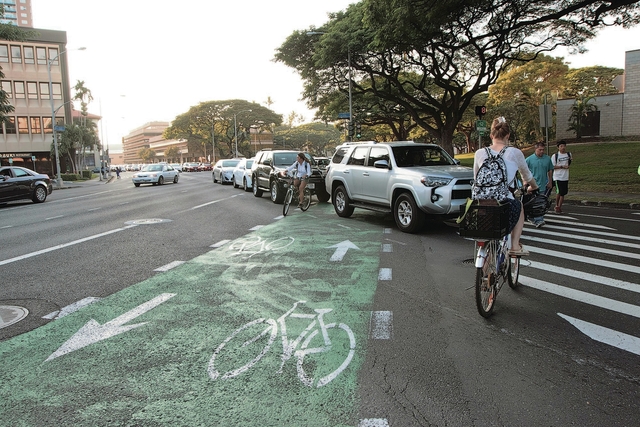After a year of heightened debate over bike lanes in Honolulu, local transportation officials on Wednesday pitched to the public their latest plans to gradually make the city’s car-saturated urban core more bike-friendly.
Those plans still involve a bike lane along South Street, starting at Ala Moana Boulevard, that would link to the controversial King Street cycle track, perhaps as early as this spring. After getting some resistance to plans for the South Street lane late last year, the city changed the designs to try to better accommodate nearby businesses.
The city also aims to add a bike path along McCully Street by the end of this year that would likely replace parking along that corridor. Eventually, under city transit plans, new bike lanes would appear on other key mauka-makai corridors, such as Piikoi Street and Ward Avenue.
“I think we’re going to see a big change in Honolulu over the next few years,” Mark Garrity, the city’s deputy director for transportation, told some 200 local residents and business owners who attended Wednesday’s public meeting at the Neal S. Blaisdell Center about the upcoming bike lane plans.
Those lanes, Garrity and other officials said, would cap a years-long push by the city to make Oahu, with its headache-inducing traffic congestion and year-round pleasant weather, a better place to get around via bike.
Cyclists represented just 1 percent of all commuters on Oahu in 2014, and it’s hovered there since 2006, the latest U.S. census numbers show. On Wednesday, Mayor Kirk Caldwell said he would consider it a victory if that number climbed to
5 percent.
Caldwell reiterated his support for the King Street lane, which has spurred polarizing debate among local business owners, drivers and cyclists since its installation a little more than a year ago.
“I want to keep it, but I want more people to be comfortable with it. Change is hard,” Caldwell told the crowd. City transit officials say some 700 cyclists now typically use the King Street lane from 6:30 a.m. to 6:30 p.m. — even if the lane often looks unused at times. They hope a better grid system will boost those numbers.
Additionally, city officials reported that vehicle drive times along the full length of the King Street cycle track, from South Street to University Avenue, have increased an average 51 seconds since the lane was installed.
The outcry over the King Street cycle track led the Honolulu City Council last year to consider Bill 68, a measure that would have given the Council a lot more say over bike lane plans but would have also slowed the progress of their installation. The bill was later deferred.
Wednesday’s meeting closely resembled a similar public briefing on bike lanes held in September, with city transit officials repeatedly stressing that they want to collect as much public input on their plans as possible.
Many of those who attended encouraged them to forge ahead with the bike lanes. “It’s about time. Anyone who’s tried to search endlessly for parking around town should just get a bike,” Kakaako resident Flora Ling said outside the meeting.
Waikiki resident Kathryn Henski told the audience that she prays every time her daughter, an 18-year-old triathlete, bikes from Kapiolani Park to Makapuu. “By golly, let her come home,” Henski said Wednesday. “Bikes are not represented in this city at all. We need people who are coming here to be comfortable — to exercise but to be able to do it safely.”
Steve Sullivan, a vice president for operations at the Waterfront Plaza complex, reiterated concerns he voiced last year that South Street was not a good road for a bike lane. Nonetheless, on Wednesday he said he appreciated the design changes the city made to those lanes, which should be installed in the coming month.
The South Street route will now be a protected two-way lane where the road is one-way, city officials say. Where car traffic runs both ways on South, the bike lanes will be separated into single lanes running on both sides of the street.
The city’s plans to create a grid network of bike lanes in the urban core also comes as the city prepares for its first major bike-share program, where cyclists can rent bikes at various stations to get around town. That program, Bikeshare Hawaii, is slated to start this summer. Bikeshare Hawaii CEO Lori McCarney said Wednesday that more bike lanes would help the venture succeed.
The process to install those lanes will take time, McCarney added. “It’s not overnight. It’s a building process,” she said.

